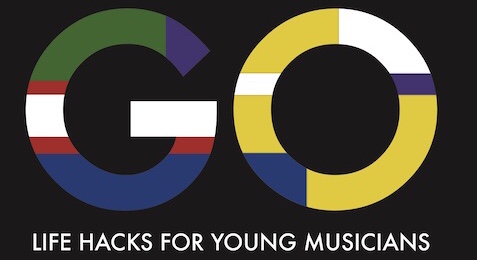Suddenly this girl appeared out of nowhere and fell to the floor. There was an audible gasp from the audience and just for a couple of seconds everyone thought it was part of the act. . .
—Guy Adams, Circus-goer in Norwich, England
If you’re great at teaching music but have never given (or received) lots of career advice, you’re in the right place. In this article, you’ll learn the three principles all music students need in order to position themselves for success: strong finances, effective networking, and meaningful relationships.
The best part? I’ve cut this chapter down from all the studies and citations (which I’m sure you’re sick of) to include just the action items.
Now:
The untimely death of trapeze artist Eva Garcia shocked an audience of 700 on an English summer day in 2003. Few at the time questioned the lack of a net because they understood that the performers were working as professionals.
In the end, the final fall could only have been violent and direct. The circus owner, perhaps in a state of shock equaling the audience’s, claimed that the performance actually needed to be enacted without a safety net because positioning one would compromise the trick. Of course, postmortem Garcia had no comment on the matter. Her death reminds us of the certain strength and safety in planning for unexpected moments. Failure to install a net leads to tragedy.

Here’s the deal:
No-one deserves the ending Garcia met.
Just like flying trapeze artists, musicians need to position their own safety net to know that when they fall, there will be something to catch them. Artists deserve a net composed of financial freedom, savvy networking, and loving relationships.
Net of Financial Freedom
Let’s start by establishing clear goals for the future with the expectation of growth. The magic number should be 20; plan to work with at least 20 hours weekly to create. This provides enough time for you to treat the music as a part-time job to actively schedule and build around.
An Artist’s Budget
As it becomes more acceptable to accumulate high amounts of debt in pursuit of an education and comfortable lifestyle, frugality will save time in the short- and long-term. I know this is counter-cultural. Only by acknowledging this challenge head-on can you expect to have the 20+ weekly hours so essential to investing in your craft.
Budget management haunts the lives of people from all different walks of life, not just artists. According to the Federal Reserve Board, 47 percent of American consumers would not be able to cover a $400 expense unless they sold something they owned or borrowed money, which makes it pretty obvious Americans struggle to manage their finances effectively.
Such a situation creates instability and extra stress from month to month. Musicians need neither. Financial freedom is a zero-sum game made up of dollars and cents. An extra job devoted to servicing any kind of debt taken on as an unplanned expense represents time taken away from getting above and beyond your 20+ hour goal of creative time per week.
This net starts with defining the lowest common denominator of financial flexibility that you are willing to accept. Now is the best time to act on this. Take time to look at the numbers of your monthly expenses. Consider how much is needed to pay the following items:
- Savings······································································································ $_____
- Debt············································································································· $_____
- Rent············································································································· $_____
- Utilities······································································································ $_____
- Groceries··································································································· $_____
- Transportation······················································································· $_____
These do not have to be large numbers; in most cases, they should not be. They must be explicitly defined, however, so that you can know what is your acceptable standard of living. The items above qualify as base expenses as opposed to discretionary spending, which consist of leisurely activities like eating out at restaurants and going to the movies.
Since time is made with money, minimize discretionary expenses to keep your time commitments free to pursue your craft. Also, don’t skip savings. Even if it is only $5 monthly, just do it. Aim for the $400 mark if you have nothing. When I was in music school, I set up a $50 monthly direct deposit into a Roth IRA, a retirement savings account that was difficult to access. I forced myself to make sure that money was there for transfer every 30 days. Looking back, I realize the money didn’t matter nearly as much as the habit of saving.
Looking back, I expected my frequent and early musical successes as a teenager and twenty-something to take me from glory to glory. The details of my financial life, however, did not take care of themselves without the intervention of others assisting me, at which point I owed them favors I was not always enthusiastic to return. Youth has its advantages, but naivety isn’t one of them.
Credit Cards
Most young people in college (ages 18-24) earn at least $7,500 annually in 2018. Use of these earnings has been trending in the right direction even as base college earnings have declined when accounting for inflation over the past ten years. In 2008 average credit card debt for this age group amounted to $3,173, nearly 40 percent of annual earnings. This level was an increase from an average debt of $2,327 in 2002.
Students have taken note from the poor decisions of their parents and currently hold $709 on average in credit card debt, outpacing all other age groups by far.
At this point, the bigger financial goal involves taking care of your base expenses so you can make music. Everything else should be peripheral. The credit card spending rates are alarming because of the high interest rates charged for outstanding balances, which is usually somewhere around 12 to 19 percent. This costs musicians a great deal of time and money.

Consider the following: credit card companies make 31.5 percent of their revenue charging interest rates with 15 percent of total revenue coming from card users between the ages of 18-26.
Accounting for differences in data measurement, 12.72 million students between the ages of 18-26 paid $1.49 billion in credit card interest.
That’s an average of $117 per student paying interest fees to credit card companies in 2015. You might look at that number and say it is no big deal. I look at that number and say you don’t have time to be paying MasterCard or any other card company for a service that provides a negligible benefit to your career.
Do credit cards represent some evil force to avoid at all costs? The answer is complicated in my view. When musicians pay off credit cards on time for base expenses, good things happen. Many banks allow users to accumulate points they can redeem toward the reduction of daily expenses such as travel and groceries.
However, the psychological cost of credit card use requires equal consideration.
Prelec and Simester have found that credit card holders spend up to 100 percent more on products than their cash-carrying counterparts. In a digitally connected world, the notion of interacting with others without a credit card seems hugely inconvenient. As an artist, however, carrying cash is not just a question of frugality. Spending less means saving time to devote to that weekly 20+ hour goal of creativity. If this goal is in danger of compromise, a credit card will not be necessary.
School Loans
Imagine that Michael owes $3,000 in credit card debt with a 16 percent APR. APR stands for annual percentage rate, so a 16 percent APR would break down to 1.33 percent in monthly charges. If he pays the debt off in three years, he can expect to pay $778 in interest alone, which is approximately equivalent to an entire month of earnings for a typical college student.
If Michael borrows $10,000 toward school loans at a 6 percent interest rate with the intention of paying it off in the same amount of time, he would pay $926 in interest. This is more interest, but there are some important differences.
First, the money is stretched farther because the interest rate is lower. Michael pays $148 more in interest, but he is getting more value because he borrowed three times as much money.
Second, the type of interest matters to the Internal Revenue Service. Taxpayers can currently deduct the expense of student loans from taxes owed, but they cannot deduct the expense of credit card debt. This shows that it matters not just how much you borrow, but where you borrow.

The cost of acquisition is something many overlook when they place themselves on the path to a traditional higher education. Looking back on my own experiences, it is not surprising to see how this could lead to unanticipated consequences.
I enrolled at Oral Roberts University in Tulsa, Oklahoma when I was not even old enough to vote.
Before signing those loan applications, I remember reading that the debt would stay with me whether I finished my degree or not. Follow-up research conducted years afterward reminded me that bankruptcy would probably not discharge the loans either unless I could prove “undue hardship” such as going to a fraudulent school, being stuck in a cycle of poverty, or suffering from mental illness.
Depending on the kind of loan obtained, not even death would terminate the loan. With some private companies, it would result in the full balance being immediately due to the co-signer (probably your parents). Not cool.
At this time, President Trump’s budget proposals for fiscal year 2018 would eliminate all undergraduate loans after 15 years of repayment. Of course, this would apply to federal loans only.
Debt levels for students of the arts are just as high if not higher than other majors. In 2016 their average student loan debt per borrower (including those who never graduated) was $28,400, while college graduate debt in general averaged $16,033.
While there are obvious long-term benefits to education, debt taken on without careful thought can hijack an artist’s career and burn the entire safety net before you have the chance to begin. There are specific pros and cons to consider, so do not assume that the pros automatically outweigh the cons just because they do for everyone else around you. You will need a special kind of financial net that places a premium on your freedom, so don’t compare your financial situation to that of others your age. Their world will not be like yours.
Financially indebted young adults can also expect more stress, which makes it hard to focus on what really matters: investing 20+ hours weekly in creative focus. Artists with limited assets who acquire high levels of school loans without a specifically defined way to pay everything off should expect high degrees of stress and a weak safety net.
No matter where your money comes from, remember that there will be strings attached. It does not matter if the loans come from the government, credit card companies, friends, or family. Loaned money is an expectation and potential means of control from whoever gave you the money that will almost certainly be used to influence your behavior. When you manage your own money, you manage your freedom and your life.
Net of Savvy Networking
Musicians on the outside looking in on the world they wish to join can succumb to the myth of networking as calculated zero-sum exchanges to negotiate commissions and concerts. This is not networking, not even in business. The key to developing a safety net to catch and propel you upward is much simpler. There exists no formula or trick. Its users look for opportunities to take genuine interest in the lives of others.
Saxophonist Michael Shults understand this anti-zero sum mentality better than many. His outlook to networking starts with a pejorative capital “N.” Anytime a musician is trying to force a connection with others, the chances of success decrease. Instead of forcing, what are the steps to networking success?
- Build friendships with others over time based on similar interests and outlooks on life.
- Show up to the performances of those you wish to connect with, then follow up with a quick note sharing what you enjoyed.
- Practice being friendly with a smile. Your behavior will always follow suit.
- Search for the chance to help not out of a desire to exploit a situation, but out of sincerity and kindness. Look for moments to connect fellow artists with opportunities to perform, write, or paint.
- Focus on your field of expertise by finding other artists to help, encourage, appreciate, and mentor.
Together, these actions will grow a net of networking based on connections with others who do things that you admire and respect.
When it comes to progress, there is no place for personal competition and animosity. The most brilliant minds in Silicon Valley know it. In his book Zero to One venture capitalist Peter Thiel describes competition as a disease that corrupts human thinking and hinders us from creating value. By destroying the opportunities of others, both the attacker and the attacked lose because the attacker wastes time and energy on destroying others when he could have been applying that energy to help others, improve himself, and create value in the world.
Theoretical Approach
Risk analyst Nassim Nicholas Taleb can also assist in developing our net of networking. The Forbes-renowned influencer describes seemingly random and unpredictable moments in life as symbolized by the rare and elusive Black Swan. The Black Swan possesses three important characteristics:
- Everyone is convinced that its possibility does not exist or its presence is taken for granted. In either case, the opposite occurs.
- The effect of the event creates an extreme impact.
- After the event, everyone explains it away—contending it was completely predictable in 20/20 hindsight.
These events seem highly improbable for those who do not expect them. However, Taleb argues that everyone should expect to encounter a Black Swan moment at some point in their life. In fact, one should be actively seeking them.

Black Swans lead to self-discovery. Artists constantly open themselves up to the unknown by seeking unexpected events. They connect by actively relaxing and letting their instincts take over when meeting new people, accepting that some acquaintances will be instantly attracted while others will be repelled. That’s alright. With new experiences you increase your self-discovery and the possibility of a Black Swan through sheer volume of interaction.
Practical Application
In the net of networking, Taleb’s insights on accidental discovery take an edge that can boost artistic connection. Within a social environment, there are three steps to apply:
- Know as much as possible about the specific industry you want to be in (names, personalities, important performances, locations).
- Join the conversation by attending every industry-related event. Get ready to start conversations with low expectations and an openness to see what could happen.
- When a Black Swan moment happens, trade contact info, follow up within two days, and state your willingness to help them. With mentors, share your work with them and express enthusiasm for their efforts.
Taleb’s clarity of thought crescendos to a high point when we consider the actions of public diplomats. They instinctively understand that breakthroughs do not happen via the everyday email and telephone call but through following the rules of cocktail parties and the possibility of impactful chance encounters.
Thus, if you want to find Black Swan moments when meeting others, here are the rules:
- Speak less than you listen
- Talk about yourself only 15 percent of the time
- Give others valuable information
- Don’t try to meet everyone
Serendipity happens only occasionally for those who infrequently seek it, but those who develop a net of networking expose themselves to situations where the likelihood of meaningful connection increases.
When following this way of thinking, discovery is no longer a question of if, but rather of when. Even if you consider yourself an introvert and do not typically frequent cocktail parties, this strategy can make all the difference. Here are some other great strategies to connect:
- Share art online
- Attend a jazz club
- Visit an art gallery
- Sit in or participate in a masterclass
- Attend a lecture
I can relate to this approach through a meeting with famed saxophonist Kenny Garrett. In 2010 I was studying saxophone in Madrid and attended one of Garrett’s concerts at the Fernán Gómez Centro Cultural de la Villa across the street from Madrid’s famous wax museum with its Pablo Picasso and Michael Jackson impressions. Going to this concert was a great moment. I had struck up a connection years before in St. Louis with a talented NYC-based pianist named Johnny Mercier who was touring with Garrett.
After following up with him on Facebook, Mercier insisted that I join him backstage to meet Garrett after the concert. After passing beyond the black curtains and fluorescent halls of the theater, I was led into a small green room that was not actually green at all to speak with Garrett directly. The cavernous concrete space provided context for the meeting of a young saxophonist’s lifetime. Garrett’s demeanor was friendly and professional, and he was curious to know my ideas. He asked questions about reeds and mouthpieces and how this affected his timbre compared to years past.
Today, I realize he was listening intently for signs of opportunity for connection. Garrett was looking for a Black Swan in me, a perfect stranger. He might not have needed me for his net, but he understood that natural intrigue combined with chance encounters creates powerful connection.
Net of Loving Relationships
Celebration after a success creates a culture of achievement in life. It gives us powerful emotional goals for future pursuits. At the other end of the spectrum, the comfort of sharing burdens with others can release stress and leave us feeling supported when setbacks occur.
For the musician a net stabilizes a culture of support to know that no matter what happens, love and acceptance will follow. How does one develop this net? What if they come from a family where support is a rare thing? Not every artist is born into the world with equal opportunity.
In the case of the net, those who act with openness and disclosure can expect to receive the same from those around them. This behavior increases safety and support for the artist. Oxytocin can lead artists to believe in themselves and the goodwill of others. It literally affects the human state of mind.
Oxytocin, sometimes referred to as the “love hormone,” holds one of the most important keys to building the net. It is secreted from the pituitary gland, which is about the size of a pea and located at the base of your brain. This hormone plays a role in establishing trust between humans in risky social situations, allowing them to accept higher degrees of uncertainty with confidence.
Activate Oxytocin

There are some effective ways to initiate this cycle. Serial entrepreneur James Altucher has taken some time to compile a list of actionable items that can increase connection and bonding with others.
Ten Unusual Ways to Release Oxytocin into Your Life
- Hug someone, especially if it is someone you love.
- Give money away, especially if it means something to you.
- Shoot guns in a safe and responsible way with a friend.
- Take a walk (or run) outside.
- Watch comedy. Read some jokes.
- Do some meditating, which basically just means to sit in silence and quiet the mind.
- Eat eggs, bananas, and pepper, although probably not all together.
- Listen to relaxing music.
- Call a friend and ask them how they’re doing.
- Use social media to send a kind greeting to an old friend.
None of the above suggestions fit well with a packed schedule and lifestyle. This scientific oxytocin strategy conforms with a time-honored tradition of planned rest. Balance is just as important to generating oxytocin as it is to achieving work in a deep state of concentration. Here, we learn that rest engenders connection.
When someone does not plan to step away from the demands of life and grows addicted to their work, they expose themselves to stress and reduce opportunities to connect with others. To get the opposite effect, the artist should make time to do nothing at all.
The Ultimate Safety Net
Eva Garcia’s fall from the trapeze was a tragic accident that will remain forever engrained in the minds of her colleagues and onlookers. Had she benefitted from the presence of a net, however, her response during the actual fall would have been equally critical to the presence of the net itself. Garcia had to know how to fall was just as important as where and when to fall.

All of us have thought about the hazards associated with pursuing a career in the arts. Kansan soprano diva Joyce DiDonato takes great joy in sharing career advice with aspiring young artists. Her comments about the beginning of her career serve as a powerful reminder that the responsibility lies with the individual to make decisions about his or her career.
DiDonato confesses “I give myself permission at any moment to walk away. I don’t want to be a prisoner to this career. I want to constantly choose it, and I want to constantly put myself in a position where I’m still loving it.” DiDonato could have drawn inspiration from German-American opera and lieder singer Lotte Lehmann, who once recounted a story of a young singer carefully questioning his career choice. Lehmann described the moment: “When a young singer asks me, ‘Shall I give up?’ I say, ‘Because you ask me, yes!’”
The points resound with advice I received from pianist and composer Cheryl Bocanegra. She taught me that a music career will work with the net only if you demand that it works, you need it to work, and love it more than anything else. If this sounds like Eric Thomas’s story about breathing from Chapter Six, you’re right. Once built, the net remains. The choice to jump or walk away rests on the artist’s shoulders alone.
The artist must not be a slave to their pursuits, motivated by fashionable trends and the safety net below seemingly beckoning us to jump against all odds. The overtures of teachers, friends, and family members may resonate and flatter, pushing you to jump one more time toward the swing of the trapeze and the attempt of that next album. The choice, however, is not theirs to make.
Be ready to stick to your convictions and give up everything necessary to fulfill your goals. Otherwise, know when to walk away and have the courage to do so if necessary. There exists a delicate balance between finding a thousand ways not to do something on the path to that Louis Pasteur-inspired eureka solution to vaccine development and admitting when a chosen path no longer serves your best interests like Steve did selling lemonade.
Whatever you do, look before you leap.

Jacob Hallman is a classically trained saxophonist, arranger, educator, and entrepreneur. He obtained his MM from the University of Missouri and has studied with Richard D. Ives, Richard Rath, Leo Saguiguit, Dan Thomas, Arthur White, Francisco Martinez, Rocío Samper, Luis Del Valle, Richard Ducros, Marc Chisson, Frederic Borey, and Matt Otto. He has recorded and commissioned music from Cheryl Bocanegra, Michael E. Anderson, Christian Lauba, and Joshua Peterson. He is the author of Ready Set Go: Life Hacks for Young Musicians.

2 comments found
Jasmine Hewitt
This article makes so much sense! Anyone attending college for music should read this!
StudyGate
Thanks Jasmine!